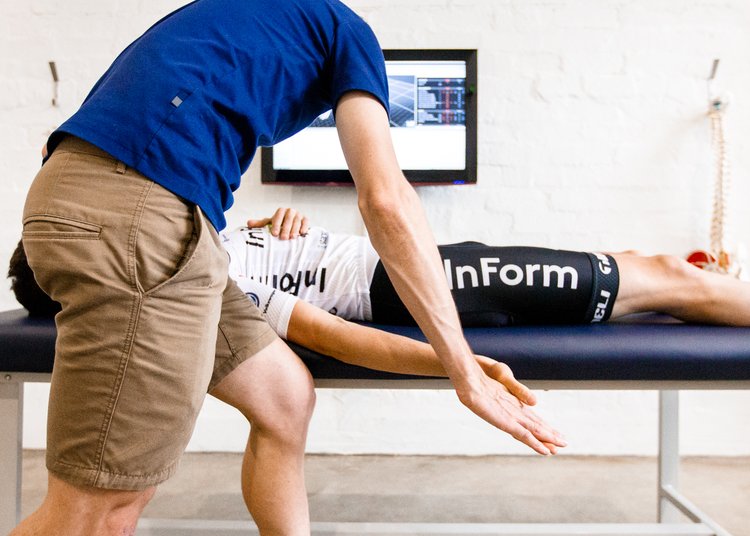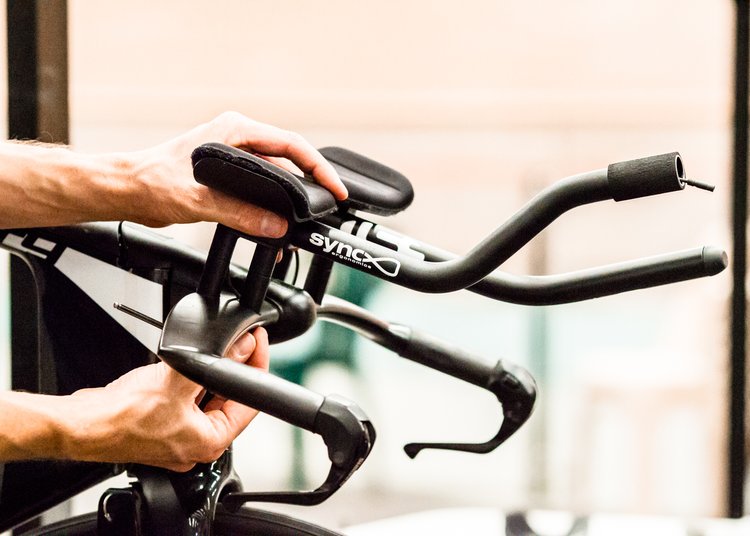Clinical Considerations of the High-Hands Position
12th Jan 2024
We often talk about the performance gains that come from the use of the Project 0.2 ecosystem, but we also know that performance should never come at a cost to comfort. We recently sat down with Connor McKay from The Physio Movement, to discuss the clinical considerations of the high-hands position and the outcomes on comfort.
SYNC ERGONOMICS: We know that the high-hands position is more effective from an aerodynamics standpoint, we’ve shown that many times in aero testing, but how does the design influence comfort?
CONNOR MCKAY: When considering comfort, the high-hands position works thanks to greater elbow flexion. Ulnar deviation (cocking the wrist towards the pinky side of your forearm) is necessary for an effective time-trial position, however it can be quite an uncomfortable position when the forearms are flat (straight and S-bend extensions). Using a high-rise extensions and angled arm support rectifies this source of discomfort.
SYNC ERGONOMICS: One of our key challenges when planning the Project 0.2 ecosystem was exactly this. We know that we wanted a 30-degree grip angle, but we were never able to get this with the height that is required to properly execute the high-hands position.
CONNOR MCKAY: The height gain really is the key thing here. Because the higher the hands are, the more the elbow is flexed and by having the elbows flexed, slight ulnar deviation is more achievable. The shape of the High Rise 3D extensions really facilitates this, by kicking up to gain the extra height necessary before still maintaining the 30-degree grip angle.
SYNC ERGONOMICS: We know that the high-hands position is more effective from an aerodynamics standpoint, we’ve shown that many times in aero testing, but how does the design influence comfort?
CONNOR MCKAY: When considering comfort, the high-hands position works thanks to greater elbow flexion. Ulnar deviation (cocking the wrist towards the pinky side of your forearm) is necessary for an effective time-trial position, however it can be quite an uncomfortable position when the forearms are flat (straight and S-bend extensions). Using a high-rise extensions and angled arm support rectifies this source of discomfort.
SYNC ERGONOMICS: One of our key challenges when planning the Project 0.2 ecosystem was exactly this. We know that we wanted a 30-degree grip angle, but we were never able to get this with the height that is required to properly execute the high-hands position.
CONNOR MCKAY: The height gain really is the key thing here. Because the higher the hands are, the more the elbow is flexed and by having the elbows flexed, slight ulnar deviation is more achievable. The shape of the High Rise 3D extensions really facilitates this, by kicking up to gain the extra height necessary before still maintaining the 30-degree grip angle.

SYNC ERGONOMICS: With your background, can you provide the reader with the anatomical considerations that are at play here?
CONNOR MCKAY: Really, there are two key types of tissue that we need to be mindful of. Wrist and elbow position effects both the muscles of the forearm and one of the main nerves that innovates the upper limb.
Muscular Considerations:
Firstly, the elbow flexion provided by the Project 0.2 ecosystem reduces “tension” on the forearm muscles. Extensor Carpi Ulnaris (ECU) – the forearm muscle which works to extend the wrist and perform ulnar deviation – originates from the lateral epicondyle of the humerus, meaning its length is impacted greatly by elbow angle. The Extensor Carpi Radialis Longis and Brevis (ECRL and ECRB), like the ECU, originate from the lateral epicondyle of the humerus. So not surprisingly, the ECRL and ECRB are impacted by elbow flexion.
The ECRL and ECRB are your wrist extensors and, along with the ECU, are likely the muscles you feel as “tension” in the forearms when the hands are in a low position on the TT bike.
Neural Considerations:
The other main consideration is tension along the radial nerve, generally made worse by ulnar deviation, especially with a more extended elbow. It’s one of the most overlooked considerations, but getting the hands up high and flexing the elbow allows for reduced radial nerve tension.
Impact on the radial nerve can inhibit the ability for the forearm to supinate and for the hand/fingers to extend properly, but one of the key signs of neurological involvement is altered sensations (numbness and tingling) in the hand, especially the thumb, middle and index finger.
“Wrist and elbow position effects both the muscles of the forearm and one of the main nerves that innovates the upper limb”
SYNC ERGONOMICS: I presume pain in the region of the forearm is a key motivator for time trial athletes to seek your services?
CONNOR MCKAY: Just this week I had a patient complaining of exactly this – he had moved to ski-tip extensions on a Giant Trinity, which was certainly able to help him achieve a higher hand position, however he was becoming uncomfortable in the ECU region after long periods on the bike while training for his Ironman. We trialed the Project 0.2 ecosystem on his bike and he immediately described the changes from the wedging as “pain-relieving”. It really goes to show that comfort and performance aren’t mutually exclusive.

SYNC ERGONOMICS: Elbow flexion is the main consideration, but achieving this relies on a considered approach to all three components.
CONNOR MCKAY: In a traditional position involving S-bend or straight extensions, it is difficult to achieve the ulnar deviation required to grasp the bars firmly, due to tension on the muscular and neural structures coursing the forearm. It’s logical that the extension needs to provide the height gain, to achieve a more flexed elbow.
But this aside, the key thing for me is the Arm Cup Wedges. The extensions give you the height and the elbow flexion, but the wedge is what supports the forearm being in that position. The high-hands position is only comfortable when properly supported. Further support is provided by the depth of the Arm Cups themselves, which improve lateral stability, reducing the load on the shoulders and helping to maintain your time trial position.
SYNC ERGONOMICS: That last comment pretty much sums up our own experiences and our athlete/customer feedback. We love having the hands up high, but resting your entire upper body mass on the points of your elbows is downright uncomfortable and does not promote a stable time trial position. We have seen people look for a solution in the type of pad (thickness and density), when really the solution is to increase surface area and contact with the forearm.
CONNOR MCKAY: The thing that drew my attention to the system as a solution for myself and our clients at TPM is a considered approach to the biomechanical requirements of an effective time trial position. The Project 0.2 ecosystem resolves one of the long-standing problems in achieving a great TT position, improving comfort and performance in the process.

About The Physio Movement and Connor McKay
The Physio Movement (Townsville, AUS) is a cutting-edge multidisciplinary allied health clinic based in North Queensland, with a focus on developing and rehabilitating endurance athletes. Connor McKay is a qualified Physiotherapist and APA member with a number of years’ experience in treating musculoskeletal conditions, including working with Olympic-level triathletes. He is also venturing into elite-level triathlon and has raced worldwide, previously being ranked #1 U25 athlete worldwide. His formal bike fit training was completed Internationally (in the Netherlands) and he has worked with a number of renowned Australian physiotherapists and bike fitters to ensure that his patients achieve the best results possible.
The Physio Movement - Associated Service Provider
At Sync Ergonomics we are delighted to have The Physio Movement on board as an Associated Service Provider, using the Project 0.2 ecosystem within their time trial position optimisation services. Connor’s clinical experience and technology driven service, combined with his sporting background in triathlon, make him the ideal service provider to truly understand what Sync Ergonomics brings to the table. It’s refreshing to see that cyclists and triathletes in Queensland have an experienced, viable option for professionally delivered position optimisation services.
